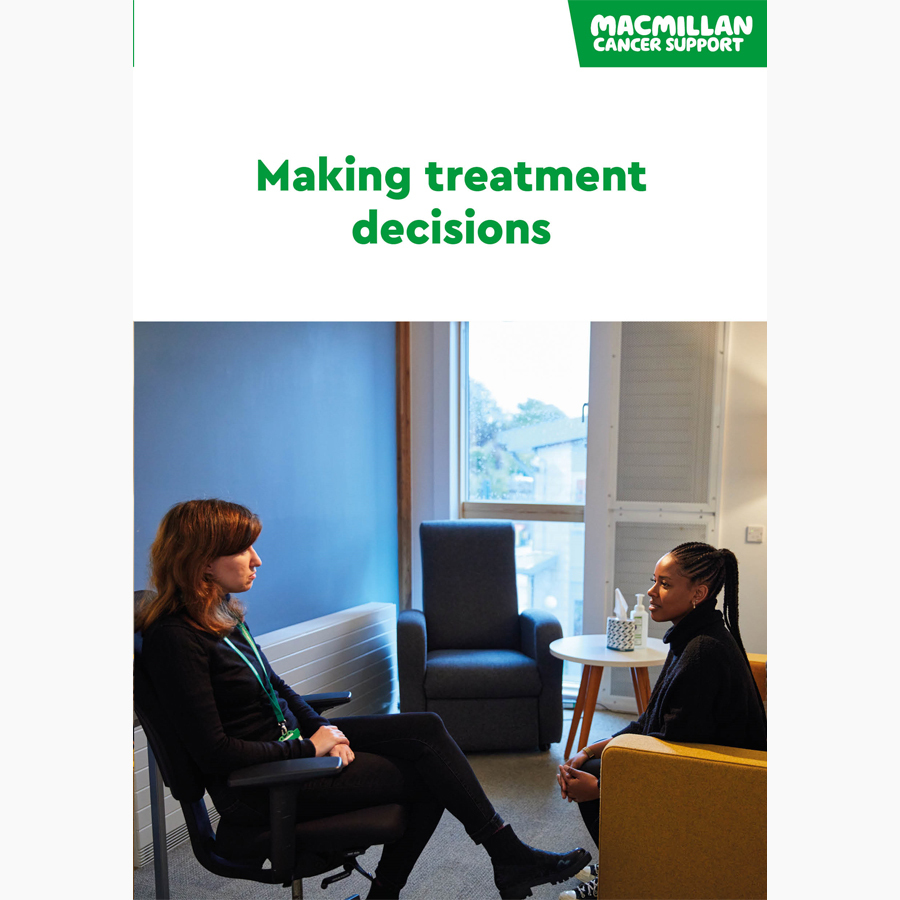Decisions about surgery for DCIS
It is helpful to think about the possible advantages and disadvantages of each operation before you make a decision.
Choice of treatment
A wide local excision (WLE) and a mastectomy work equally well for treating DCIS. This means your surgeon and breast care nurse may ask you to decide which type of surgery you feel is right for you.
Your surgeon and nurse can explain what is involved and any possible side effects of each treatment. They will help you decide on the treatment that is best for you.
If DCIS is large, or in more than 1 area, your surgeon will recommend a mastectomy.
Having breast surgery can affect many areas of your life, including your body image, sex life and relationships. It is important to take your time and have all the information you need to make the right decision.
It is helpful to think about the possible advantages and disadvantages of each type of surgery before making a decision.
Related pages
Booklets and resources
Breast-conserving surgery and radiotherapy
Advantages
- It aims to keep most of your breast tissue and a good breast shape.
- You usually recover faster than after a mastectomy, and have a lower risk of complications.
- It may be less likely to affect your sex life and relationships.
Disadvantages
- You may need more than 1 operation to get clear margins.
- You may need radiotherapy after surgery. Some people will also need radiotherapy after a mastectomy.
- Radiotherapy has short-term side effects. Some people may have long-term side effects.
Mastectomy
Advantages
- You may not need radiotherapy after a mastectomy. But some people will need it. Ask your cancer doctor about this.
- Even though a WLE and a mastectomy work equally well, you may feel less worried after a mastectomy. This is because the breast tissue has been removed.
Disadvantages
- You lose your breast permanently.
- It usually takes longer to recover after having a mastectomy, and there is a slightly higher risk of complications.
- It changes your appearance, which may affect your confidence, sex life and relationships.
- If you want breast reconstruction, you will need a longer operation and possibly more surgery. Breast reconstruction is usually more than 1 operation. But reconstruction may help to reduce other disadvantages.
Your surgeon and breast care nurse can answer any questions you may have and tell you what to expect. They may be able to show you photographs of others who have had surgery.
You may find it helpful to talk to others who have had the surgery. Your nurse may know whether there is a local support group, where you can talk to someone who has had a similar operation.
You may also be able to find people in a similar situation through our Online Community or the Breast Cancer Now online forum.
About our information
-
References
Below is a sample of the sources used in our ductal carcinoma in situ (DCIS) information. If you would like more information about the sources we use, please contact us at cancerinformationteam@macmillan.org.uk
British Medical Journal (BMJ). Best Practice. Breast cancer in situ. 2020. Update 2023. Available from: bestpractice.bmj.com [accessed 2023]
ESMO. Early breast cancer clinical practice guidelines for diagnosis, treatment and follow-up. 2019, Vol 30, pp1192–1220. Available from: www.esmo.org/guidelines/guidelines-by-topic/breast-cancer/early-breast-cancer [accessed 2023].
National Institute for Health and Care Excellence (NICE). Early and locally advanced breast cancer: diagnosis and management. 2018. Updated 2023. Available from: www.nice.org.uk/guidance/ng101 [accessed 2023].
-
Reviewers
This information has been written, revised and edited by Macmillan Cancer Support’s Cancer Information Development team. It has been reviewed by expert medical and health professionals and people living with cancer. It has been approved by Dr Rebecca Roylance, Consultant Medical Oncologist and Professor Mike Dixon, Professor of Surgery and Consultant Breast Surgeon.
Our cancer information has been awarded the PIF TICK. Created by the Patient Information Forum, this quality mark shows we meet PIF’s 10 criteria for trustworthy health information.
The language we use
We want everyone affected by cancer to feel our information is written for them.
We want our information to be as clear as possible. To do this, we try to:
- use plain English
- explain medical words
- use short sentences
- use illustrations to explain text
- structure the information clearly
- make sure important points are clear.
We use gender-inclusive language and talk to our readers as ‘you’ so that everyone feels included. Where clinically necessary we use the terms ‘men’ and ‘women’ or ‘male’ and ‘female’. For example, we do so when talking about parts of the body or mentioning statistics or research about who is affected.
You can read more about how we produce our information here.
Date reviewed

Our cancer information meets the PIF TICK quality mark.
This means it is easy to use, up-to-date and based on the latest evidence. Learn more about how we produce our information.




